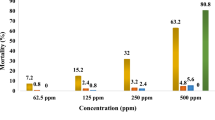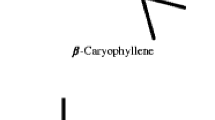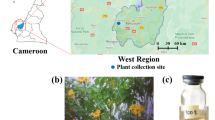Abstract
The biological activity of djulis (Chenopodium formosaneum) extracts was evaluated against mosquitoes and biting midges. Djulis extracts were relatively nontoxic to Aedes albopictus larvae. However, they showed interesting repellence against adult mosquitoes as estimated by the median effective dosages (ED50). ED50 values for djulis extracts against mosquito adults in descending order were: seed extracted with methanol (0.83 %), seed extracted with dichloromethane (0.66 %), leaf extracted with methanol (0.50 %), and leaf extracted with dichloromethane (0.40 %). Field tests also suggested that djulis methanol extracts were effective at about a 1 % level against biting midges (Forcipomyia taiwana). A total of 15 and 20 compounds accounting for 88.8 and 79.9 % in the seed and leaf extract, respectively were identified by gas chromatography coupled to mass spectrometry (GC–MS). Among these, 9, 12-octadecadienoyl chloride, (Z, Z) was found in both as well as being the major constituent in the leaf extract (35.7 %). Further studies on the repellent property of the extracts against mosquitoes and biting midges are warranted.

Similar content being viewed by others
References
Amakua M, Coutinhob FAB, Massadb E (2011) Why does dengue and yellow fever coexist in some areas of the world and not in others? Biosystems 106:111–120
Anitha M, Paulpriya K, Muthukumarasamy S, Mohan VR (2012) GC-MS Analysis of bioactive components of Cynoglossum zeylanicum (Vahl Ex Hornem) Thunb. Ex. Lehm. (Boraginaceae). Current Pharma Res 2:615–619
Antwi FB, Shama LM, Peterson RK (2008) Risk assessments for the insect repellents DEET and picaridin. Regul Toxicol Pharmacol 51:31–36
Bird TG, Hedin PA, Burks ML (1987) Feeding deterrent compounds to the boll weevil, Anthonomus grandis Boheman in rose-of-sharon, Hibiscus syriacus L. J Chem Ecol 13:1087–1097
Chio EH (2007) A quick insecticide bioassay with mosquitoes. Formosan Entomol 27:261–266
Chio EH, Yang EC (2008) A bioassay for natural insect repellents. J Asia Pac Entomol 11:225–227
Chou YC, Prakash E, Huang CF, Lien TW, Chen X, Su IJ, Chao YS, Hsieh HP, Hsu TA (2008) Bioassay-guided purification and identification of PPAR a/g agonists from Chlorella sorokiniana. Phytother Res 22:605–613
Chuang YY, Lin CS, Wang CH, Yeh CC (2000) Distriubution and seasonal occurrence of Forcipomyis taiwana (Diptera: Ceratopogonidae) in the Nantou Area in Taiwan. J Med Entomol 37:205–209
Corbel V, Stankiewicz M, Pennetier C, Fournier D, Stojan J, Girard E, Dimitrov M, Molgo J, Marc Hougard J, Lapied B (2009) Evidence for inhibition of cholinesterases in insect and mammalian nervous systems by the insect repellent DEET. BMC Biol 7:47
Finney DJ (1971) A statistical treatment of the sigmoid response curve, 3rd edn. Cambridge University Press, Cambridge
Ganesan K, Mendki MJ, Suryanarayana MVS, Prakash S, Malhotra RC (2006) Studies of Aedes aegypti (Diptera: Culicidae) ovipositional responses to newly identified semiochemicals from conspecific eggs. Aust J Entomol 45:75–80
Gerber FJ, Barnard DR, Ward RA (1994) Manual for mosquito rearing and experimental techniques. Am Mosq Contr Assoc Bull 5:1–98
Gubler DJ (1998) Dengue and dengue hemorrhagic fever. Clin Microbiol Rev 11:480–496
Katz TM, Miller JH, Hebert AA (2008) Insect repellents: historical perspectives and new developments. J Am Acad Dermatol 58:865–871
Keil DE, McGuinn WD, Dudley AC, Eudaly JG, Gilkeson GS, Peden-Adams MM (2009) N,N,-diethyl-m-toluamide (DEET) suppresses humoral immunological function in B6C3F1 mice. Toxicol Sci 108:110–123
Lipscomb JW, Kramer JE, Leikin JB (1992) Seizure following brief exposure to the insect repellent N,N-diethyl-m-toluamide. Ann Emerg Med 21:315–317
Morimoto M, Urakawa M, Fujitaka T, Komai K (1999) Structure–activity relationship for the insect antifeedant activity of benzofuran derivatives. Biosci Biotechnol Biochem 63:840–846
Murray CJ, Rosenfeld LC, Lim SS, Andrews KG, Foreman KJ, Haring D, Fullman N, Naghavi M, Lozano R, Lopez AD (2012) Global malaria mortality between 1980 and 2010: a systematic analysis. Lancet 379:413–431
Ohmura W, Doi S, Aoyama M, Ohara S (1999) Components of steamed and non-steamed Japanese larch (Larix leptolepis (Sieb. et Zucc.) Gord.) heartwood affecting the feeding behavior of the subterranean termite, Coptotermes formosanus shiraki (Isoptera: Rhinotermitidae). Holzforschung 53:569–574
Okunade AL, Wiemer DF (1985) (-)-loliolide, an ant-repellent compound from Xanthoxyllum setulosum. J Natl Prod 48:472–473
Ponlawat P, Scott JG, Harrington LC (2005) Insecticide susceptibility of Aedes aegypti and Aedes albopictus across Thailand. J Med Entomol 42:821–825
Posy DC, Mohamed MA, Coppel HC, Jeanne RL (1984) Identification of an ant repellent allomone produced by the social wasp Polistes fuscatus (Hymenoptera: Vespidae). J Chem Ecol 10:1799–1807
Regnault-Roger C, Vincent C, Arnason JT (2012) Essential oils in insect control: low-risk products in a high-stakes world. Annu Rev Entomol 57:405–424
Scheffrahn RH, Rust MK (1983) Drywood termite feeding deterrents in sugar pine and anti termitie activity of related compounds. J Chem Ecol 9:39–55
Silva WJ, Dória GA, Maia RT, Nunes RS, Carvalho GA, Blank AF, Alves PB, Marçal RM, Cavalcanti SC (2008) Effects of essential oils on Aedes aegypti larvae: alternatives to environmentally safe insecticides. Bioresour Technol 99:3251–3255
Smith CM (2011) Biochemical plant defenses against herbivores: from poisons to spices. In: Seekbach J, Dubinsky Z (eds) Cellular origin, life in extreme habitats and astrobiology. Springer Sciences + Business Media B. V, Dordrecht, pp 287–310
Stuart AE, Brooks CJ, Prescott RJ, Blackwell A (2000) Repellent and antifeedant activity of salicylic acid and related compounds against the biting midge, Culicoides impunctatus (Diptera: Ceratopogonidae). J Med Entomol 37:222–227
Tsai PJ, Sheu CH, Wu PH, Sun YF (2010) Thermal and pH stability of betacyanin pigment of djulis (Chenopodium formosanum) in Taiwan and their relation to antioxidant activity. J Agric Food Chem 58:1020–1025
Wang YN, Wang HX, Shen ZJ, Zhao LL, Clarke SR, Sun JH, Du YY, Shi GL (2009) Methyl palmitate, an acaricidal compound occurring in green walnut husks. J Econ Entomol 102:196–202
Wang YN, Wang HX, Jin YS, Bu CY, Cheng J, Zhao LL, Shi GL (2010) Assessment of the contact toxicity of methyl palmitate on Tetranychus viennensis (Acari: Tetranychidae). J Econ Entomol 103:1372–1377
Wantke F, Focke M, Hemmer W, Götz M, Jarisch R (1996) Generalized urticaria induced by a diethyltoluamide-containing insect repellent in a child. Contact Dermat 35:186–187
Warren BR, Rouseff RL, Schneider KR, Parish ME (2007) Identification of volatile sulfur compounds produced by Shigella sonnei using gas chromatography–olfactometry. Food Control 18:179–182
Weaving AJS, Sylvester NK (1967) Pyrethrum as an insect repellent, Part II: a laboratory technique for its evaluation as a mosquito repellent and the influence of formulation on persistence. Pyrethrum Post 9:31–35
Xu H, Li G, Liu M, Xing G (2006) Oviposition deterrents in larval frass of the cotton boll worm, Helicoverpa armigera (Lepidoptera: Noctuidae): chemical identification and electroantennography analysis. J Insect Physiol 52:320–326
Yeh CC, Chuang YY (1996) Colonization and bionomics of Forcipomyia taiwana (Diptera:Ceratopogonidae) in the laboratory. J Med Entomol 33:445–448
Acknowledgments
We would like to thank Mr. J. C. Lin for his efforts to guide us to the field and collect the djulis leave for us. This species was later identified as C. formosaneum (Koidz) by Prof. Y. P. Yang in the Department of Biological Sciences in National Sun Yat-Sen University. The djulis seed was a gift from Dr. K. C. Kao at BAPHIQ, Taiwan. We thank Ms. S. H. Huang who maintained the mosquito colony and provided assistance. Finally, a research grant (NSC-97-2811-B-002-006 & 97-2321-B-002-013-MY3) from the National Science Council, The Executive Yuan, Taiwan, ROC is kindly acknowledged.
Author information
Authors and Affiliations
Corresponding author
Additional information
Communicated by M. B. Isman.
Eddie Hang Chio and En Cheng Yang contributed equally to this study.
Rights and permissions
About this article
Cite this article
Chio, E.H., Yang, EC., Huang, HT. et al. Toxicity and repellence of Taiwanese indigenous djulis, Chenopodium formosaneum, against Aedes albopictus (Diptera: Culicidae) and Forcipomyia taiwana (Diptera: Ceratopogonidae). J Pest Sci 86, 705–712 (2013). https://doi.org/10.1007/s10340-013-0500-3
Received:
Accepted:
Published:
Issue Date:
DOI: https://doi.org/10.1007/s10340-013-0500-3




